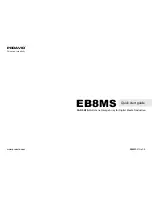
16
User's Guide Fireface 802
© RME
Buffer Size
The setting
Buffer Size
determines the latency between incoming and outgoing ASIO and WDM
data, as well as affecting system stability (see chapter 9.1).
Errors
does not refer to buffer errors, but USB and FireWire transmission errors. The display
will be reset on any start of a playback/record. More information can be found in chapter 38.3 /
38.4.
Options
DSP – EQ+D for Record
Switches EQ and Dynamics of all input channels into the recording path. In case Loopback has
been activated the EQ and Dynamics of the Output channel are within the recording path. See
also chapter 27.5.
ADAT2
This optical TOSLINK output can operate as ADAT or AES/SPDIF output.
AES Input
Defines the input for the AES (SPDIF) signal. 'AES' relates to the XLR socket, 'ADAT2' to the
second optical TOSLINK input.
TMS
activates the transmission of Channel Status data and
Track Marker information. In case these information are not required the feature should be turn-
ed off.
AES Output
The AES output signal can have the Channel Status Professional or Consumer (SPDIF). This
setting is also valid when ADAT2 has been set as AES output. For further details please refer to
chapter 21.2.
Word Clk Out
The word clock output signal usually equals the current sample rate. Selecting
Single Speed
causes the output signal to always stay within the range of 32 kHz to 48 kHz. So at 96 kHz and
192 kHz sample rate, the output word clock is 48 kHz.
Clock Mode
Sample Rate
Sets the currently used sample rate. Offers a central and comfortable way of configuring the
sample rate of all WDM devices to the same value, as since Vista the audio software is no
longer allowed to set the sample rate. However, an ASIO program can still set the sample rate
by itself.
During record/playback the selection is greyed out, so no change is possible.
Clock Source
The unit can be configured to use its own clock (Internal = Master), or one of the input signals
(Word, AES, ADAT1 and ADAT2). If the selected source isn't available (Input Status No Lock),
the unit will change to the next available one (AutoSync). If none is available then the internal
clock is used. The current clock source is displayed as
Current
.
Pitch
More information on Pitch is available in chapter 7.2.
Input Status
Indicates for each input (Word, AES, ADAT1, ADAT2) whether there is a valid signal (Lock, No
Lock), or if there is a valid
and
synchronous signal (Sync). The third column shows the sample
frequency detected by the hardware (coarse recognition, 32 kHz, 44.1 kHz, 48 kHz etc.). In
Clock Mode
the clock reference is shown. See also chapter 38.1.
Summary of Contents for Fireface 802
Page 7: ...User s Guide Fireface 802 RME 7 User s Guide Fireface 802 General...
Page 12: ...12 User s Guide Fireface 802 RME...
Page 13: ...User s Guide Fireface 802 RME 13 User s Guide Fireface 802 Installation and Operation Windows...
Page 28: ...28 User s Guide Fireface 802 RME...
Page 29: ...User s Guide Fireface 802 RME 29 User s Guide Fireface 802 Installation and Operation Mac OS X...
Page 38: ...38 User s Guide Fireface 802 RME...
Page 39: ...User s Guide Fireface 802 RME 39 User s Guide Fireface 802 Inputs and Outputs...
Page 47: ...User s Guide Fireface 802 RME 47 User s Guide Fireface 802 Stand Alone Operation...
Page 50: ...50 User s Guide Fireface 802 RME...
Page 51: ...User s Guide Fireface 802 RME 51 User s Guide Fireface 802 TotalMix FX...
Page 53: ...User s Guide Fireface 802 RME 53...
Page 89: ...User s Guide Fireface 802 RME 89 User s Guide Fireface 802 Class Compliant Mode...
Page 94: ...94 User s Guide Fireface 802 RME...
Page 95: ...User s Guide Fireface 802 RME 95 User s Guide Fireface 802 Technical Reference...
Page 106: ...106 User s Guide Fireface 802 RME 36 Diagrams 36 1 Block Diagram Fireface 802...
Page 108: ...108 User s Guide Fireface 802 RME...
Page 109: ...User s Guide Fireface 802 RME 109 User s Guide Fireface 802 Miscellaneous...
















































